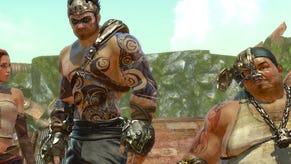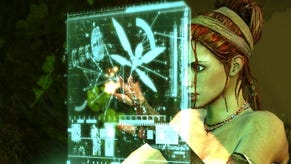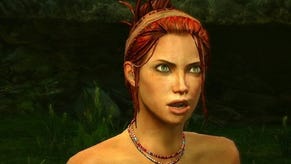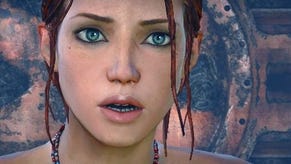Face-Off: Enslaved: Odyssey to the West
Complete analysis of Ninja Theory's Unreal adventure.
| - | Xbox 360 | PlayStation 3 |
|---|---|---|
| Disc Size | 4.9GB | 5.07GB |
| Install | 4.9GB (optional) | Up to 3.5GB (dynamic) |
| Surround Support | Dolby Digital | 5.1LPCM |
A couple of weeks back, Namco Bandai released its Enslaved: Odyssey to the West demo, effectively giving away the entirety of the game's first level. As an introduction to the basic building blocks of the gameplay, a sampling of the artistic style and a chance to get to know the two main characters, it's absolutely fine. As a showcase for the meat and drink of the full game though, you ain't seen nothing yet. Enslaved opens up massively from the second chapter onwards.
There's much to like in Enslaved, and Ellie's 8/10 review highlights the impressive production values: great acting, a superb soundtrack, an involving story and some really imaginative, well-realised art.
Gameplay-wise, the game holds your hand a little too much, but this came as something of a relief for Digital Foundry after most of the week was spent grappling with the sometimes-sadistic Castlevania: Lords of Shadow. Both of these games operate in territory where Uncharted 2 is the undisputed master, and while both have much to offer, Naughty Dog's epic is still a cut above the new challengers. In the case of Enslaved, character animation and interaction with the scenery isn't as seamless as it is in Uncharted 2, and the superb graphics are sometimes marred by some obviously low-resolution textures.
But of course, Uncharted 2 is a platform exclusive, while Enslaved is available on both HD consoles. As it's based on Unreal Engine 3 with its unified cross-platform asset management system, parity in terms of visuals is essentially a given. There is virtually nothing of note to distinguish either version of the game from the other, aside from a couple of effects that are either minor oversights or else down to differing implementations of specific effects within the UE3 architecture.
You can check out the differences yourself in the form of our usual goodies - a colossal 720p comparison gallery, along with this head-to-head video. As is always the case, use the full-screen button to get full-on resolution.
A quick look at the comparison assets shows that the differences manifest in the form of a stronger bloom on Xbox 360 along with differing shadows - most notable in cut-scenes. On 360 it seems that the shadows are being rendered correctly, whereas on PS3 there appears to be a slight offset bias. All told, actual differences in these regards are more technical curiosities as opposed to anything really worthy of further comment.
Far more apparent to the naked eye is the differing approaches to motion blur, with the 360 game using more samples in the processing, producing a smoother look, most evident in cut-scenes.

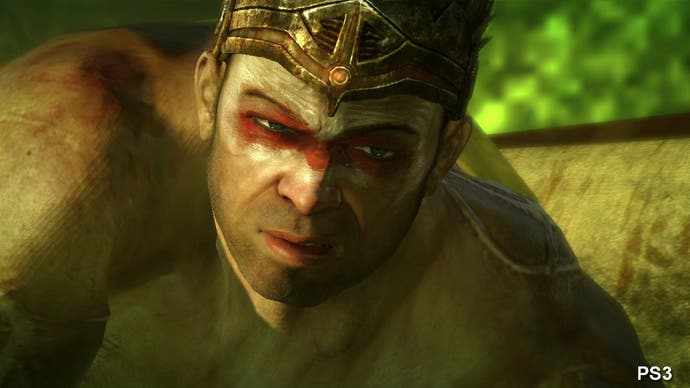


On the performance side of things, the demo analysis we did a couple of weeks back suggested that in the detail-heavy interior scenes, the Xbox 360 commanded a noticeable frame-rate advantage with lower levels of screen-tear, while other scenes were basically like for like. The obvious conclusion is that heavy scenes in UE3 tend to favour the 360 - something that's been with the case with the engine for quite some time now. We see a similar state of affairs in the full version of Enslaved, the difference being that the level setups in subsequent episodes are far, far more ambitious than anything seen in the demo.
First up, an analysis of cut-scenes taken from the first five chapters from the game. All of these are rendered using the UE3 engine (the lion's share of the cinematics in the first chapter are Bink videos) and it gives us a good opportunity to see how the tech copes under the load of some very highly detailed environments with occasionally huge draw distances.
The results seem to bear out the findings of our demo report, where highly detailed scenes cause far more problems for the PS3 than with the 360, manifesting in significantly more dropped and torn frames. There are moments of pure graphical majesty in Enslaved. The developers have made a real effort to make the journey of Trip and Monkey far more believable by creating often-colossal levels that make in-game progress feel like a long and arduous quest - a real adventure. The use of engine-driven cut-scenes to emphasise the size and scale of the path ahead is cheapened somewhat when there's a jerky refresh or wobbly visuals due to the tearing. In this respect then, the increase in performance on the 360 version of the game is significant and desirable.



